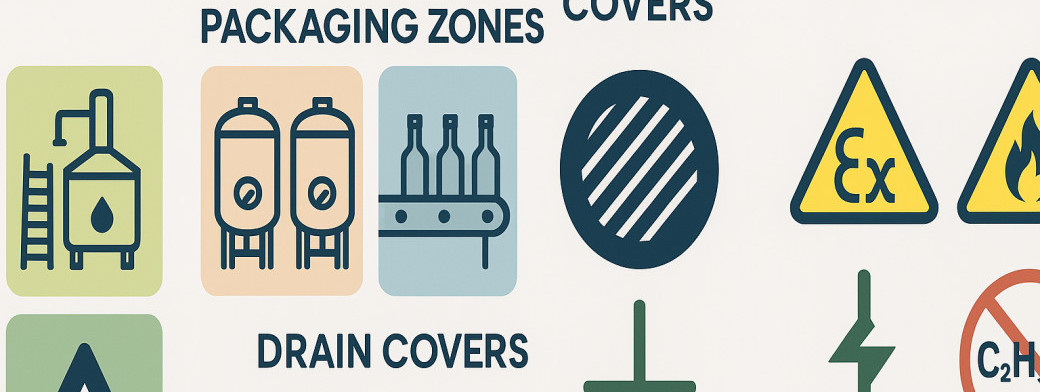
Managing Wort, Yeast & Ethanol Spills: Practical Spill Control for Breweries & Distilleries
Spill control is a critical aspect of operations in breweries and distilleries. From sticky residues that can lead to hygiene concerns to the flammability risks associated with ethanol, understanding how to effectively manage spills is essential for maintaining safety, quality, and environmental compliance.
Why Spill Control Matters
- Sticky Residues: Wort and yeast can leave behind residues that attract pests and create hygiene issues.
- Slip Risks: Wet floors from spills increase the likelihood of slips and falls.
- Ethanol Flammability: Ethanol spills pose a significant fire risk, requiring immediate and effective response.
- Hygiene and Quality: Maintaining a clean environment is crucial for product integrity.
- Environmental Protection: Preventing spills from contaminating drains and watercourses is vital for compliance.
- Downtime and Brand Risk: Spills can lead to production stoppages and damage brand reputation.
Regulatory Backdrop
In the UK, breweries and distilleries must adhere to several regulations to ensure safe operations:
- HSE and COSHH Duties: Employers must assess risks and implement controls for hazardous substances.
- Environment Agency Expectations: Compliance with environmental regulations to prevent pollution.
- DSEAR/ATEX Considerations: Proper handling of flammable liquids and vapours to prevent explosions.
- Trade Effluent Consents: Adhering to local water company regulations regarding waste disposal.
Hazard Mapping
Understanding where spills are likely to occur is crucial for effective spill management. Common fluids and spill locations include:
- Typical Fluids: Wort, beer, yeast slurry, CIP chemicals, ethanol, fusel oils.
- Common Spill Locations:
- Mash/Lauter/Kettle
- Whirlpool
- Fermentation Vessel (FV)/Cooling Tank (CT) areas
- Yeast brink
- CIP skid
- Spirit store
- Tanker offloading
- Bottling/Canning
- Cask/Keg racking
- Barrel warehouses
- Spirit pipework/Pumps
Controls
Implementing the right controls is essential for effective spill management:
- Food-Safe, Low-Lint Absorbents: Using plant-based fibres to minimise contamination.
- Universal Absorbents: Suitable for aqueous liquids, wort, and yeast spills.
- Chemical Absorbents: For handling caustic or acidic spills safely.
- Anti-Static Options: Particularly important around flammable liquids; ensure proper earthing and bonding.
- Drain Protection: Utilise covers, mats, and gel seals to prevent spills from entering drains.
- Bunding and Spill Pallets: For IBCs and drums, ensuring containment of potential spills.
- Drip Trays: Install under pumps and hoses to catch leaks and drips.
- Interceptors and Sump Housekeeping: Regular maintenance to prevent blockages and spills.
- Ventilation and Ignition Source Control: Essential around ethanol handling areas.
- Floor Care: Implementing measures to reduce slip risk, such as non-slip flooring.
Kit Strategy
Having the right spill kits in place is essential. Consider the following:
- Zone-Specific Kits: Tailor kits for key areas including brewdeck, cellars, packaging halls, tanker bay, spirit store, and barrel warehouse.
- Oil-Only vs Universal vs Chemical Selection: Oil-only pads are not suitable for aqueous or ethanol mixes; ensure appropriate selection based on the fluid type.
- Kit Sizing and Placement: Ensure kits are adequately sized and strategically placed for rapid access.
- Signage: Clearly label spill kit locations for easy identification.
- Restock and Inspection Routines: Regularly check kits for readiness and restock as necessary.
Procedures & Training
Establishing clear procedures and training staff is vital for effective spill response:
- SOPs for Transfers and CIP: Develop standard operating procedures for fluid transfers and cleaning processes.
- Ethanol-Safe Response Steps: Stop flow, isolate the area, ventilate, and control ignition sources during an ethanol spill.
- PPE Selection: Ensure appropriate personal protective equipment is available and used during spill response.
- Toolbox Talks and Drills: Regularly conduct training sessions and spill response drills.
- Near-Miss Reporting: Encourage reporting of near-miss incidents to improve safety measures.
- Contractor and Night-Shift Briefings: Ensure all personnel, including contractors, are briefed on spill management protocols.
Waste & Evidence
Proper waste management is essential for compliance and hygiene:
- Segregating and Storing Used Absorbents: Properly handle absorbents contaminated with flammable materials.
- Handling Yeast/Wort Wastes: Implement procedures to manage yeast and wort wastes effectively.
- Drain Contamination Prevention: Take steps to prevent spills from entering drainage systems.
- Records for Audits: Maintain logs of spill incidents, inspections, and training for audit purposes.
Practical Tools
Utilise these tools for effective spill management:
- One-Page Audit Checklist: A concise checklist to ensure all spill control measures are in place.
- Step-by-Step Spill Response Flow: Clear, actionable bullets for responding to both aqueous/wort spills and ethanol/flammable spills.
Mini Case Vignette
Consider a realistic incident: An ethanol leak during spirit transfer occurred due to a faulty connection. The root cause was identified as insufficient training on equipment handling. Controls applied included immediate isolation of the area, activation of the spill response kit, and repair of the faulty connection. Outcomes included reduced downtime and thorough documentation of the incident, ensuring readiness for audits.
FAQs
- What absorbents should I select for ethanol vs aqueous spills? Use chemical absorbents for ethanol and universal absorbents for aqueous spills.
- Are oil-only pads appropriate for ethanol spills? No, they are not suitable for ethanol or aqueous mixes.
- What anti-static considerations should I keep in mind? Ensure all absorbents and equipment are anti-static rated in flammable zones.
- Where should I place drain covers? Place them in areas where spills are likely to occur, especially near processing and storage areas.
- How often should I test kit readiness? Regular checks should be conducted at least monthly or after any spill response.
- How do I deal with spills in confined cellars? Ensure proper ventilation and have emergency procedures in place for confined spaces.
Conclusion
Efficient spill management is vital for breweries and distilleries to ensure safety, compliance, and product integrity. By implementing robust controls, training staff, and maintaining proper waste management protocols, you can significantly reduce the risks associated with wort, yeast, and ethanol spills. For a comprehensive range of spill control products tailored to the needs of breweries and distilleries, explore SERPRO’s UK offerings.
